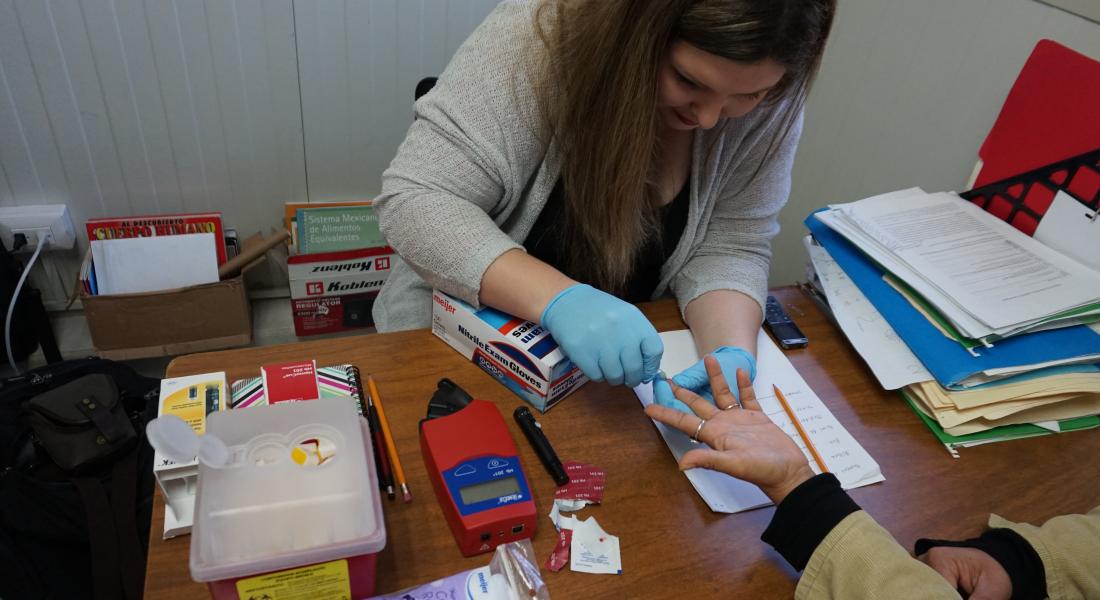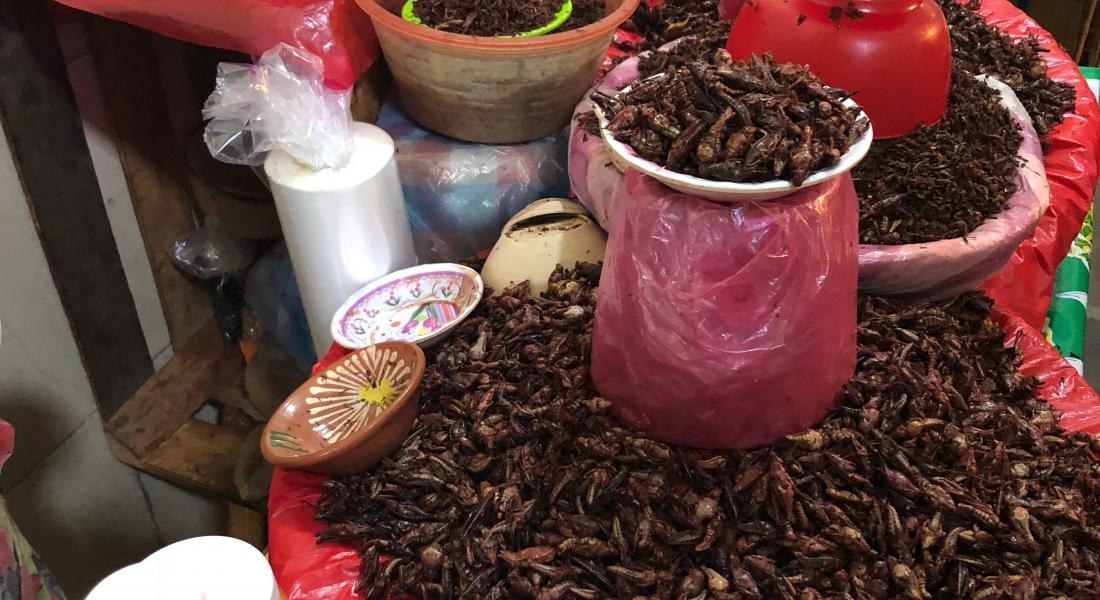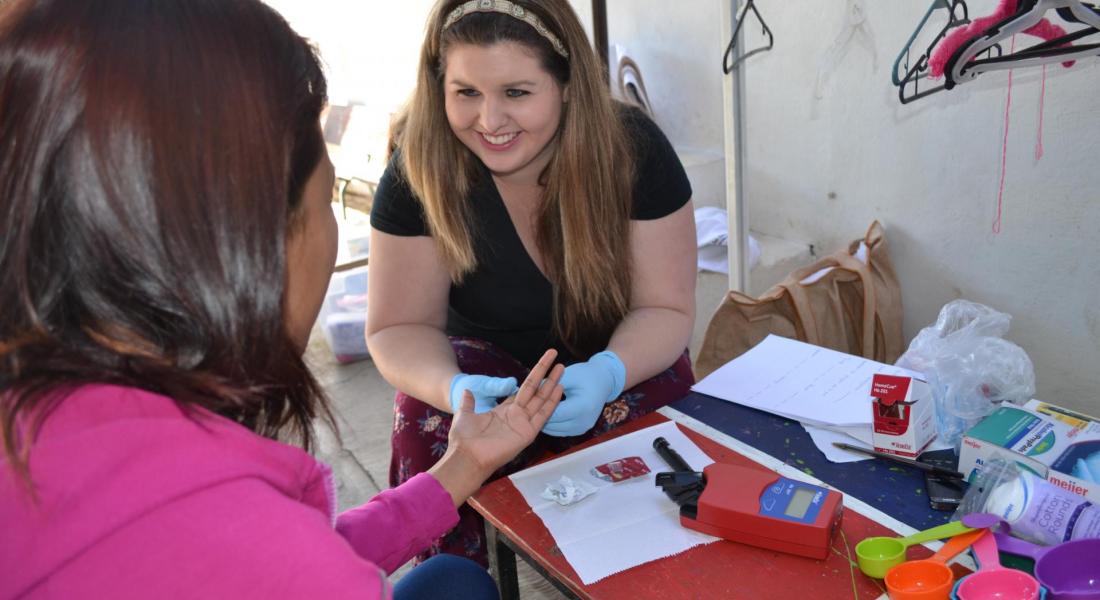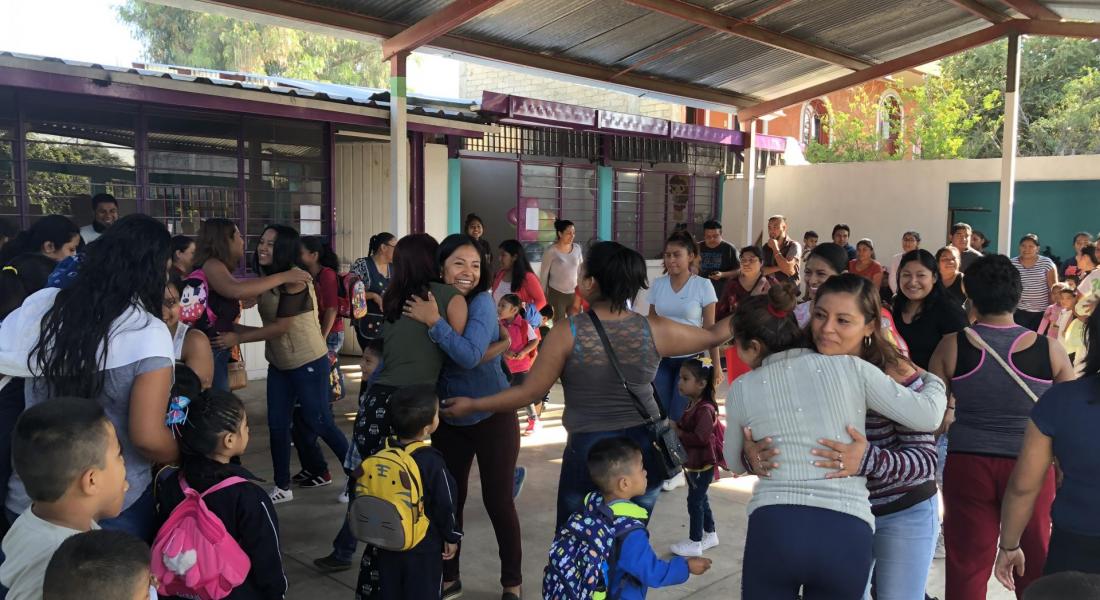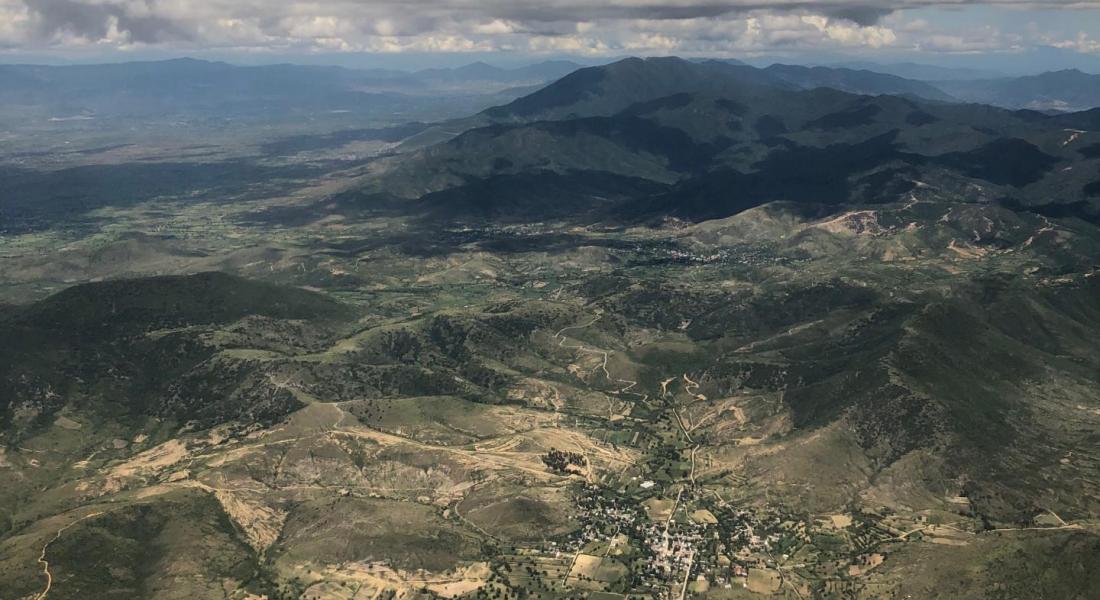From January through December 2019, Doctoral Student Affiliate Kayla Hurd (anthropology) traveled to Oaxaca, Mexico, on a Kellogg Institute Graduate Research Grant to conduct research for her project, “Exploring how Seasonality and Diet Affect Iron Levels for Adults in Oaxaca, Mexico.” Upon her return, she sent the following summary of her work.
On the surface, my project focused on food and seasonality over the course of a year in southern Mexico, however, this project was actually centered on the hospitality, warmth, and good-hearted nature of the people with whom I interviewed and developed relationships. My interviews were primarily based in a preschool, and while there, I was able to see how this community interacted and flourished in a way that I would not have otherwise if I was solely based in a clinical setting. I observed parent-teacher conferences, interactions between parents, and interactions between children. Mothers openly breastfed their babies, waiting to speak with the teacher, or even while speaking with me, and it was beautiful. The preschool was a community center that thrived on the interaction, and they made an impact on me just as much as I did on them. It is to this community, and others in Oaxaca like it, that I dedicate my work; my goal is that this work will benefit their livelihoods and wellbeing.
In January 2019, thanks to the generous funding of the Kellogg Graduate Research Grant, I traveled to Oaxaca, Mexico and began my pilot study that allowed me to test my hypotheses and future methodologies for my dissertation work in 2020-2021. From collaborations made in 2018, I met with a community health doctor and nutritionist at a local clinic to develop my study with the preschool in the suburb San Martín Mexicapan. For two weeks, we interviewed 31 parents (mostly mothers) at the preschool about their dietary habits. Using a food frequency questionnaire, I asked the mothers to write what they ate that day, yesterday, and what they ate typically during a week of that particular month. During the interview, I also asked about their insect-eating habits since my dissertation research is focused on the use of chapulines (roasted grasshoppers) in this area of Mexico and the nutritional and cultural implications of this practice. In addition to these interviews, I also performed anthropometric tests on the participants of the study (height, weight, and skinfold measurements) to understand how the body changed over the course of a year due to seasonal dietary changes. These data were further paired with hemoglobin levels in which I took a minimally-invasive blood sample via a finger prick from each participant, and using a Hemocue, I was able to easily report back that data to each individual instantaneously—a rare occurrence for people in this area, where healthcare is costly, time-consuming, and the results are not immediately provided.
After returning from the field, I began analyzing interviews in qualitative and mixed methods software (MAXQDA). Systematic approaches to coding were used to identify themes and recurring patterns among the participants (Ryan & Bernard 2003; Bernard et al. 2017). Word frequencies and keyword in context analysis were also used to differentiate between interviewer and interviewee and further assess the quality of the data collected. The interviews consisted of questions pertaining to perceptions of a diet with particular attention to meat and insects, household dynamics, and political economic constraints on health and wellbeing.
Particularly, I was concerned with three questions from my January interviews and wanted to explore them further. These three questions are: “What is meat for you?” (“¿Qué es carne para usted?”), “Do you consider insects and chapulines food?” (“Los insectos y los chapulines, ¿lo considera alimentos?”), and “Are chapulines meat?” (“¿Los chapulines son carnes?”). When asked their opinion about what meat was to them, my participants generally responded in four distinct categories. These categories consisted of animals, necessity and protection, protein, and unhealthy food. While the categories of animals, necessity, and protein all resonate as positive, healthy options of food, the fourth category juxtaposed this correlation as a few participants discussed how meat can be an unhealthy food item.
Chapulines (Photo 2) are roasted grasshoppers that are commonly sold in markets and in many restaurants around Oaxaca (Cohen et al. 2009; Hurd 2018). This insect is popular as a tourist attraction in said markets and is culturally represented by the local soccer team as their mascot as well (Hurd 2018). This insect continues to be a staple in Oaxacan culture and cuisine (Cohen et al. 2009), but globalization processes, such as NAFTA, are limiting access to nutritious and culturally appropriate foods (Gálvez 2018) as more highly processed foods are making their way into Mexican urban markets. In my upcoming work, I aim to examine more closely how this political economic and globalization constraints are effecting chapulines as a cultural food, but in this preliminary work, I aimed to showcase how perceptions of these insects are dynamic.
A majority of my participants classified insects, and more specifically chapulines, as food (64.5%), yet surprisingly, this did not correlate to their perception of insects as meat as only 29% of my participants agreed that chapulines were a type of meat. Thematically, chapulines are food due to their seasonality (almost like fruits or vegetables), cost, and Oaxacan culture. Loisa, one of my participants, laughed when I asked her if chapulines were food, nodded her head in agreement, and said that for Mexicans, yes they are food. She continued, “I think that [chapulines] contain protein… because they are natural, since they eat pure things, it benefits us too [when we eat them].” Making this connection to protein, Loisa noted the “meat-like” benefits of chapulines yet never explicitly stated if they were meat. However, she, along with many others, talked about the seasonality of chapulines and the cost associated with this seasonal food.
In January, chapulines were not in season; Oaxacan chapulines thrive during the wet season from May through October, traditionally (Cohen et al. 2009; Hurd et al. 2019). As such, Oaxacan vendors could still sell some of the chapulines from last season, however, they would not be fresh, and many locals did not buy them because of cost and freshness. Additionally, some of the chapulín vendors would get their supply from the nearby state Puebla, but locals did not like these ones either. Paula, another participant, told me that “the season was about two months or so ago. And right now the grasshoppers that they are selling [in the markets] are from Puebla or something like that. That is, they are no longer ours but are from another state. And the truth is, we do not know where they are from or how ... How they are brought [to the market], how the grasshopper is there [in Puebla] and how it reproduces and all that. I do not consume it because it is not from here, because it is not the season.” Paula further states, “I believe that grasshoppers are food because they supposedly live in the milpa, all that, they are from herbs. It comes from eating grass, which is milpa and all that. I believe that on the one hand, they are food.” As such, she much rather purchase her chapulines locally while in season because of this belief in cultural origin and seasonality.
20 participants did not classify insects as a type of meat in my interviews. More commonly, people classified them as a snack, or simply as an insect, rather than a meat due to their texture and physical characteristics. Many participants agreed that the texture was too different from that of other meat, since chapulines do not have any physical, fleshy meat on them such as a cow or chicken. Both Lupita and Ines, two other participants, characterized chapulines as “pure” since they do not have any meat and have a little shell [cascarita]. This description is particularly interesting because of the chitin that both Lupita and Ines are commenting upon. Scholarly understandings of the digestibility and health effects of chitin are just beginning, but studies have so far found chitin to be beneficial for human consumption due to its high nutritive value (Xiaoming et al. 2010).
My studies in Oaxaca continued in May, August, and December; each visit consisted of interviews, food frequency questionnaires, blood draws, and anthropometric measurements with more or less the same participants (due to the migratory flux of people to other areas for work and changing school years for their children, some parents were not available to meet with me again). In May, I focused on collecting household demographic data concerning food preparation responsibility and monetary food procurement budgets. The interviews in August were primarily geared at examining my participants’ traditional and favorite foods as well as their ideas about using grasshoppers as medicine. In December, I asked my participants about seasonal and structural constraints of obtaining food.
Preliminary analysis of my qualitative interviews and quantitative nutritional data revealed that grasshoppers are a core component of identity in Oaxaca for a majority of participants. However, women’s consumption of grasshoppers was not significantly linked to their BMI, hemoglobin levels, or percentage of calories they consumed from other traditional foods. Women who consumed more of their calories from processed foods had higher hemoglobin levels, while those who consumed a greater percentage of raw food calories had lower levels. Additionally, women with higher BMIs had higher hemoglobin levels. My future research will build from these initial results by analyzing how shifting dietary practices across seasons and shifting economic factors among Oaxacan women, including the seasonality of insect consumption, relate to changes in BMI, hemoglobin levels, and other dietary practices. Findings from this pilot study will offer preliminary evidence for the cultural and nutritional implications of food choices that are tied to larger forces out of my participants’ control, such as political economic factors and seasonality. Building upon these findings, my future dissertation research will systematically assess the role the Mexican political economy has on dietary choice and further analyze the place of grasshoppers in the diet, both culturally and nutritionally. The preliminary study was useful for: 1) piloting interview techniques, such as the food frequency questionnaire, and interview questions afford the opportunity to maximize the data quality in the dissertation research phase; and 2) it allowed me to assess the practicability of collecting biological samples and anthropometric data from her interlocutors over multiple visits.
Currently, I am working on analyzing the remainder of the data to present at the Human Biology Association annual conference in April and to prepare for publication in journals such as Social Science & Medicine and the American Journal of Human Biology. Over the four field seasons (January, May, August, and December), I collected at least 114 interviews, hemoglobin levels, and anthropometric measurements. Not to mention, 114 food frequency questionnaires in which I have to compute data pertaining to each participants’ daily and weekly caloric intake.
These data are critical for understanding how seasonality and diet affect iron levels for adults in this area, but my experience so far in Oaxaca has been more than just data collection. It has been about the people, their lives, and how political economic and structural factors affect their wellbeing. I have been lucky enough to establish relationships with my collaborators and those at the clinic and have been welcomed into their community. In December, we celebrated the holidays together and the end of my pilot study. We shared meals, laughs, and memories with one another. And with many abrazos, I ended my study with them, and I am looking forward to my return in the summer of 2020.
References
Bernard, H. R., A. Wutich, & G.W. Ryan. 2017. Analyzing qualitative data: Systematic approaches. SAGE publications.
Cohen, J. H., N. D. M. Sánchez, & F. Montiel-Ishino. 2009. Chapulines and food choices in rural Oaxaca. Gastronomica. 9: 61-65.
Galvez, A. 2018. Eating NAFTA: Trade, Food polices, and the destruction of Mexico. University of California Press.
Hurd, K.J., Shertukde, S., Toia, T., Trujillo, A., Pérez, R., Larom, D., Love, J., & Liu, C. 2019. “The Cultural Importance of Edible Insects in Oaxaca, Mexico.” Annals of the Entomological Society of America. Invited Special Issue.
Hurd, K. J. 2018. Fear and Food, Two Extremes of Human-Insect Relations. Anthropology News website. DOI: 10.1111/AN.937
Ryan, G.W. & R.H. Bernard. 2003. “Techniques to identify themes.” Field Methods 15 (1): 85-109.
Xiaoming, C., F. Ying, Z. Hong, & C. Zhiyong. 2010. “Review of the nutritive value of edible insects.” In Forest insects as food: humans bite back, edited by Patrick B. Durst, Dennis V. Johnson, Robin N. Leslie, and Kenichi Shono, 85-92. Bangkok Thailand: Food and Agriculture Organization of the United Nations Regional Office for Asia and the Pacific.






